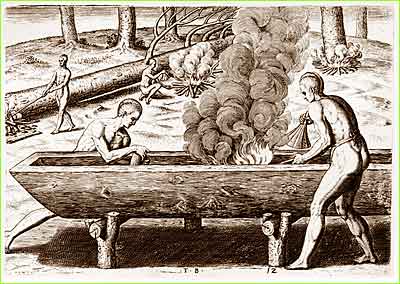By Bill Adamsen
 [click for larger photo]
[click for larger photo]Canoe at Mashantucket Pequot Museum
While visiting the Mashantucket Pequot Museum, I was thrilled to see their exhibit of a large dugout canoe carved from solid American chestnut. I was visiting the museum with my daughter and her friends and was stunned by this canoe's appearance. A full eighteen feet long, it was built from solid chestnut and the grain of the mammoth tree is still clearly visible.
Found at the bottom of West Hill Pond in northwestern Connecticut by divers in 1988, the canoe had been deliberately sunk in about 12 feet of water using rocks, perhaps to ensure it remained below the ice of the lake during the winter. West Hill Pond is located at 900+ feet elevation and ice thickness frequently reaches eighteen to twenty four inches. The pond itself bottoms out at about 65 feet – deep for lakes in Connecticut. The actual depth at time of sinking may have been perhaps four to five less, since that is the depth of the impoundment caused by the West Hill Pond dam.
The divers turned the eighteen foot long canoe over to Yale University's Peabody Museum – who in turn donated the canoe to the Mashantucket Pequot Museum in 1996 for conservation and display. More can be found at the Norwich Bulletin or at the Mashantucket Pequot Museum.
 [click for larger photo]
[click for larger photo]Canoe at Mashantucket Pequot Museum
 [click for larger photo]
[click for larger photo]Dugout canoe in process of fabrication
Apparently American chestnut dugouts were not uncommon on freshwater lakes in CT. The Connecticut State Museum also has a an example of a dugout canoe discovered during the draining of a lake in Bethel, CT back in 1911. That canoe is also estimated to be from the 16th or 17th century. The article goes on to note that all the dugout canoes found in New England have been found underwater or at the bottom of lakes where the cold water enhances preservation and inaccessibility hinders destructive access.
Chestnut would have been a preferred material for building a dugout. The wood has a high tannic acid content which makes it resistant to decay. The trees were common, grew close to the water, and the tall straight (branchless) trunks would all have made them suitable and preferred for a canoe. As one of the lightest of the hardwoods and one of the easiest to work, it would have been a natural choice of a dugout canoe builder.
Those with an interest in seeing a dugout built or in use, there are a series of educational videos produced by Gatehouse Media depicting the manufacture and use of dugout canoes called mishoonash by the Wampanoag. These are vitally important documentaries and I'm delighted they're available through YouTube.
 [click for larger photo]
[click for larger photo]Log cabin built on shores of West Hill Pond circa 1927 of American chestnut
West Hill Pond, location of the discovery of the Pequot canoe is familiar to me, having grown up playing in its woods and on its waters. I was surprised to have never heard of this discovery. I can understand someone wanting a canoe on the lake. The waters are extremely clear both as a result of an extremely small watershed, and unique limnology which provides a strong basic buffering potential. Even today one can see the bottom at ten feet or more with excellent underwater visibility.
The Pond sports two Boy Scout Camps (Camp Sequassen and Camp Workcoeman) with beautiful facilities. Today's scouts can't wait until summer to ply its waters in their own canoes.
My grandmother had a log cabin of American chestnut built on West Hill Pond shortly after the blight, and our property has many American chestnut sprouts growing and even flowering right along the shore. Perhaps one of them was the “source” of the material for this canoe?


